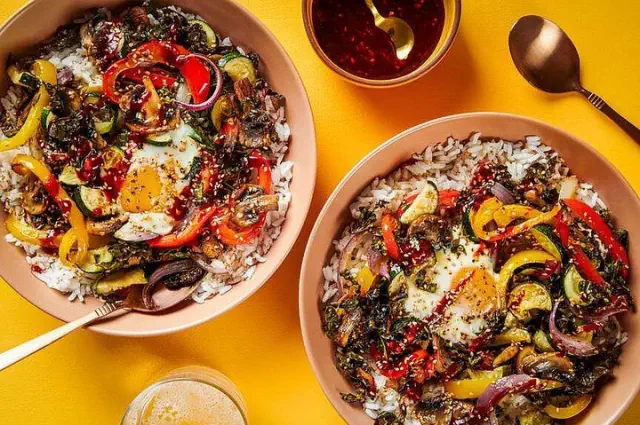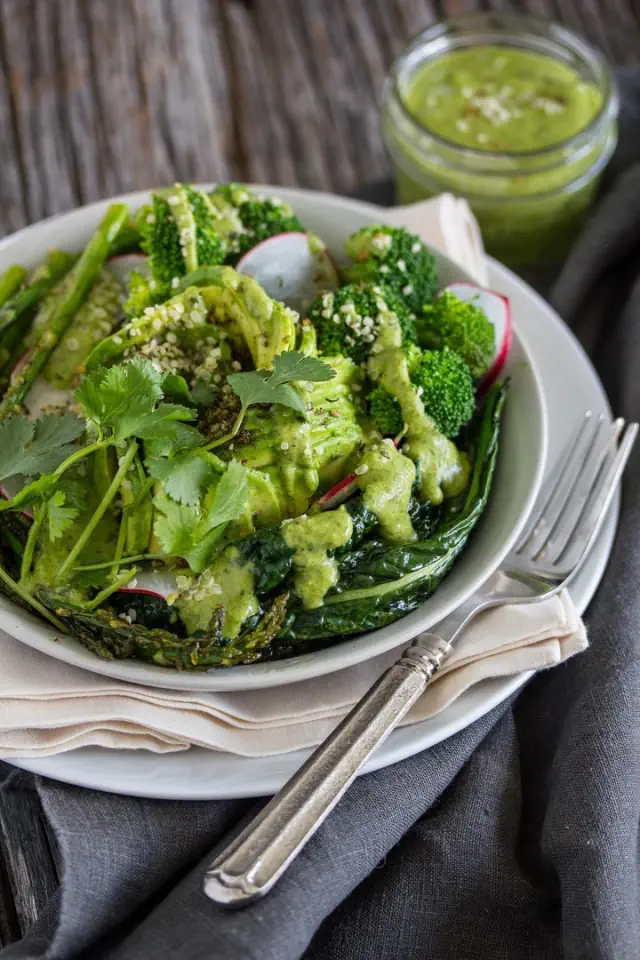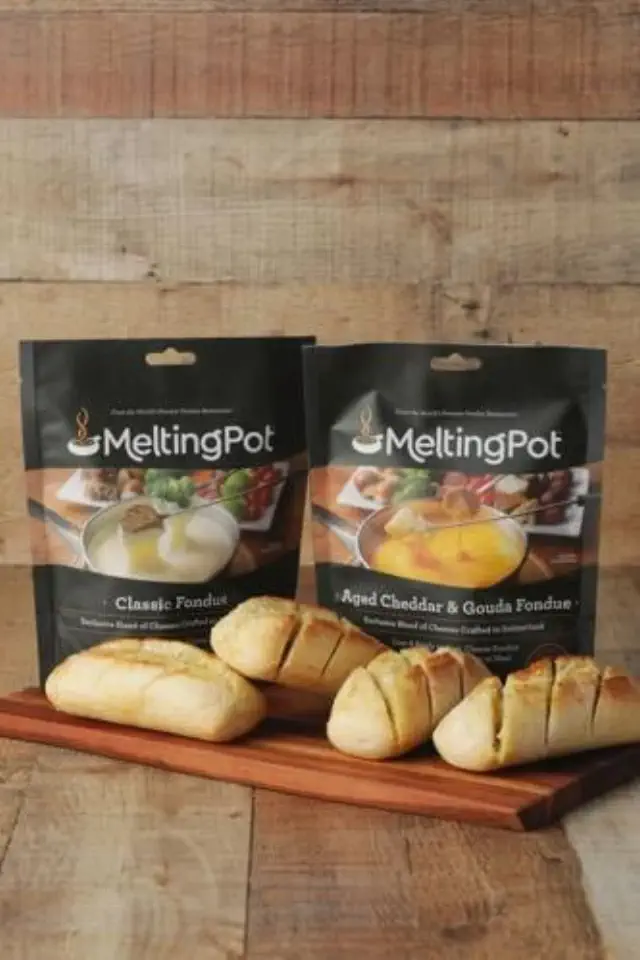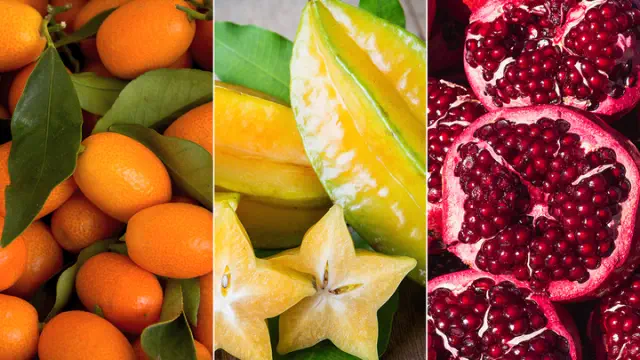
View pictures in App save up to 80% data.
Bibimbap is a vibrant explosion of flavors: a delightful mix of rice and assorted vegetables, often accompanied by meat and an egg, all brought together with a sauce that satisfies cravings for umami, sweetness, tang, and spice. This bibimbap recipe is inspired by Seji Hong's "Korean Made Easy," an excellent guide to traditional Korean home cooking. Hong is also the creator of BomBom sauces, a line of flavorful condiments based in the U.K.
In my opinion, bibimbap deserves a spot in my list of top savory dishes, specifically in the "toppings on rice" category. The term "bibimbap" translates to "mixed rice," which perfectly describes this dish. It's typically served as a bowl filled with rice topped with various ingredients that the eater combines, featuring a delightful mix of crispy and chewy textures alongside smooth, saucy morsels, all nestled within a generous helping of warm, fluffy rice.
Hong's recipe features a delightful vegetarian Yachae Bibimbap, also known as Roasted Vegetable Bibimbap. This dish is perfect for home cooks, as you can let your rice cook in a rice cooker or on the stove while a colorful assortment of vegetables roasts on a sheet pan in the oven. During this time, you can whip up a simple sauce using just five ingredients. When you're close to mealtime, simply crack a couple of eggs over the beautifully browned vegetables on the sheet pan and pop the oven door shut until the eggs reach your desired doneness.
This recipe includes kale, onions, peppers, zucchini, and mushrooms, but feel free to substitute with whatever ingredients you have available. While it's visually appealing to have a range of colors in the dish, it's also a time-honored tradition.
In her writing, Hong explains that "Obangsaek," the traditional five-colour spectrum rooted in Korean culture, symbolizes harmony and equilibrium. She elaborates that these colours correspond to cardinal directions and vital elements of life: blue/green signifies the east and wood; red represents the south and fiery energy; yellow stands for the center and soil; white denotes the west and the power of metal; and black is associated with the north and water. Hong emphasizes that this colour spectrum permeates various facets of Korean culture, including clothing, art, and cuisine. She notes that ingredients that align with these colours are thought to connect individuals to the universe's energy, imbuing them with philosophical significance.
Bibimbap perfectly illustrates the relationship between color and balance. A selection of complementary ingredients—varying in color, texture, and flavor—creates a sense of harmony, not just for your palate but also, perhaps, for your overall well-being. The concluding note in Hong's recipe says, "Mix it all together and savor the experience!"
So, the secret lies in the blend, doesn’t it? What a delightful idea! When combined, the distinct components unite, shifting from isolation to connection. As the ingredients merge, they give rise to unique tastes and sensations, evolving into something greater than just their individual elements.
YACHAE BIBIMBAP (VEGETABLE BIBIMBAP WITH ROASTED VEGGIES)
Using a sheet pan and a hot oven simplifies the preparation of these Korean vegetable bibimbap bowls. As an assortment of vegetables and mushrooms roast to perfection, prepare a pot of rice and whip up a quick sweet-and-spicy gochujang sauce. Once the vegetables are nicely browned, create small nests and crack an egg into each. In just a few minutes, the eggs will be ready, allowing you to transfer each nest onto a bed of steaming rice. Drizzle the sauce over the bowls or serve it on the side for added flavor.
2 portions
Active duration: 10 minutes. Overall duration: 30 minutes.
FOR THE VEGGIES AND EGGS:
2 tablespoons of olive oil, or additional as required
Four large kale leaves, ideally Russian or Tuscan (weighing about 6 ounces), with the thick stems removed and sliced thinly.
1 small red onion (approximately 6 ounces), cut in half and then sliced
1 small zucchini (5 ounces), cut in half lengthwise and then sliced thinly.
1 small red bell pepper, deseeded, cored, and cut into slices
1 small yellow bell pepper, deseeded, cored, and cut into slices.
6 ounces of mushrooms, like button, cremini, or shiitake, with stems removed if necessary, and sliced.
Refined salt
Recently ground black pepper
Two large eggs
FOR THE GOCHUJANG DIPPING SAUCE
2 tablespoons of gochujang
2 teaspoons of soy sauce, ideally low-sodium.
2 teaspoons of granulated sugar or light brown sugar
1 tsp of freshly squeezed lemon juice
1 clove of garlic, minced or finely shredded
Two cups of steamed white rice.
Toasted sesame oil, for garnish
Toasted sesame seeds, for garnish.
Prepare the vegetables and eggs for roasting: Adjust the oven rack to the center and preheat it to 400 degrees Fahrenheit.
If you prefer, you can line a large baking sheet with foil and then drizzle it with olive oil. Next, add the kale, onion, zucchini, bell peppers, and mushrooms to the pan. Using your hands, mix everything together until all the vegetables are evenly coated. Finally, season with a sprinkle of salt and pepper to taste.
Roast the vegetables for 20 minutes, or until they are tender and have a slight golden color on the edges. With a silicone spatula or tongs, arrange the vegetables into two circular nests about 4 to 5 inches wide, creating a small indentation in the center of each. If the pan appears dry at the bottom, drizzle a bit more olive oil into each indentation. Carefully crack an egg into each nest and sprinkle with salt and pepper. Place the sheet pan back in the oven and roast for an additional 5 to 8 minutes, or until the egg whites have turned opaque.
To prepare the gochujang sauce: As the vegetables roast, combine the gochujang, soy sauce, sugar, lemon juice, and garlic in a small bowl, mixing thoroughly until everything is well blended.
For serving, portion the rice into two bowls, placing a vegetable nest and an egg on each. Drizzle the sauce over the top or serve it on the side. If you like, finish with a few drops of sesame oil and a sprinkle of sesame seeds.
Substitutions: Red onion >> scallions, garlic scapes, or yellow or white onion. Kale >> mature spinach, bok choy, mustard greens, collards, cabbage, broccoli or cauliflower. Zucchini >> frozen winter squash, such as butternut; thinly sliced delicata squash; or fresh, chopped acorn squash. Bell peppers >> any kind of peppers or eggplant. You could also use more of any of the other vegetables. The mushrooms are really good in this dish >> but you could substitute more bell peppers or squash. In place of eggs >> add cubed firm tofu to the vegetables and roast everything together. Soy sauce >> tamari or liquid aminos. Gluten-free? >> Use tamari instead of soy sauce and look for a gluten-free gochujang.
Nutritional details for each serving: 589 calories, consisting of 86g carbohydrates, 186mg cholesterol, 21g fat, 10g fiber, 20g protein, 4g saturated fat, 851mg sodium, and 22g sugar.
Based on "Korean Made Easy" by Seji Hong (Kyle Books, 2024).










